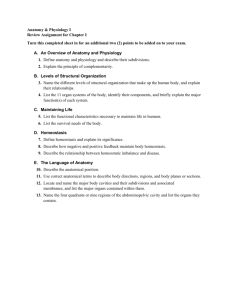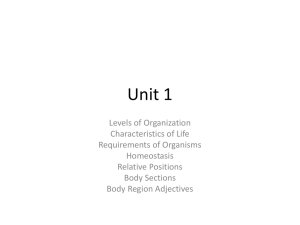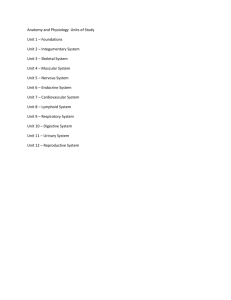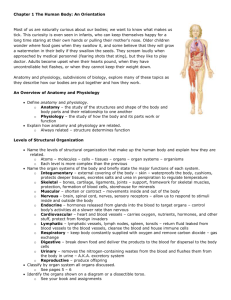Relationship Between Anatomy and Physiology
advertisement
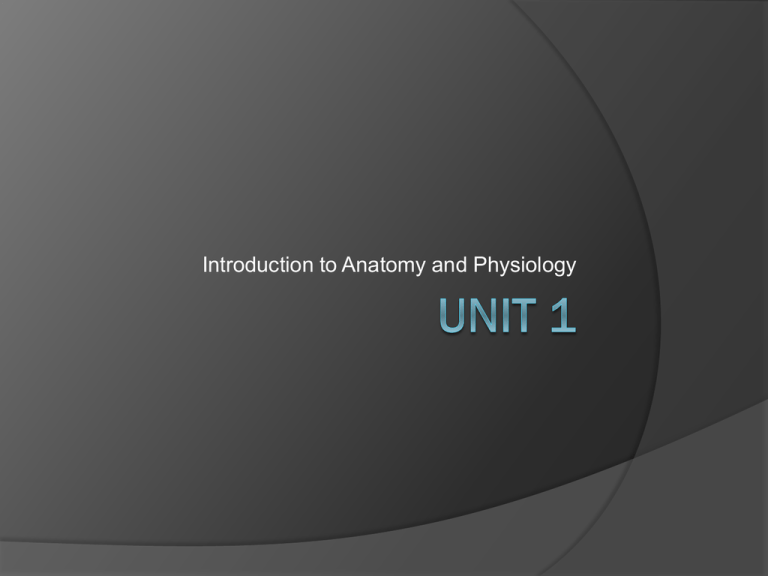
Introduction to Anatomy and Physiology Introduction to Anatomy and Physiology Relationship between Anatomy and Physiology Anatomy The study of internal and external structures of the body and the physical relationships among body parts Physiology The study of how living organisms perform their vital functions Someone studying anatomy might examine how and where a particular muscle attaches to the skeleton, whereas someone studying physiology might consider how a muscle contracts or what forces a contracting muscle exerts on the skeleton Relationship between Anatomy and Physiology Anatomical info provides clues about functions (physiology), and physiological mechanisms can be explained only in terms of the underlying anatomy ALL SPECIFIC FUNCTIONS ARE PERFORMED BY SPECIFIC STRUCTURES!!!!! Relationship between Anatomy and Physiology Anatomy can be divided into gross (macroscopic) anatomy and microscopic anatomy Gross Anatomy Examination of relatively large structures ○ Usually visible with unaided eye 5 different forms of gross anatomy Surface anatomy ○ Study of general form and superficial markings Regional anatomy ○ Anatomical organization of specific areas of body (head, neck, trunk) Relationship between Anatomy and Physiology 5 different forms of gross anatomy (con’t) Systemic anatomy ○ Study of the structure of organ systems (skeletal system, muscular system, cardiovascular system, etc.) Developmental anatomy ○ Describes the changes in form that occur between conception and physical maturity ○ Embryology – study of early developmental processes Clinical anatomy ○ Subspecialities important in clinical practice Medical anatomy (anatomical features that change during illness) Radiographic anatomy (anatomical structures seen using imaging techniques) Relationship between Anatomy and Physiology Microscopic Anatomy Study of structures that cannot be seen without magnification Has 2 major divisions Cytology – analysis of the internal structure of individual cells Histology – examination of tissues Relationship between Anatomy and Physiology Physiology The study of the function of anatomical strucures Can be divided into 4 major specialties Cell physiology – study of the function of cells ○ Chemical processes within cells and chemical interactions between cells Special physiology – study of the physiology of specific organs Systemic physiology – study of the functioning of specific organ systems Pathological physiology – study of the effects of diseases on organ or system fuctions Introduction to Anatomy and Physiology Levels of Organization The Chemical (or Molecular) Level Atoms can combine to form molecules with complex shapes The functional properties of a particular molecule are determined by its unique 3D shape The Cellular Level Molecules interact to form organelles, each of which has specific functions. Organelles are grouped to form cells The Tissue Level Groups of cells working together to perform specific functions ○ Heart muscle cells interact with other types of cells and extracellular materials to form cardiac muscle tissue Levels of Organization The Organ Level Two or more tissues working in combination to perform several functions ○ Cardiac muscle tissue, in combination with connective tissue from the bulk of the heart. The Organ System Level Two or more organs interacting ○ The heart and blood vessels work together to form the cardiovascular system. The Organism Level Highest level of organization All organ systems working together Homeostasis Homeostasis One of the roles of the organ systems in an organism is to maintain homeostasis. Homeostasis – maintaining a stable internal environment. Absolutely vital to survival Homeostatic regulation – adjustment of physiological systems to preserve homeostasis. Homeostasis 2 mechanisms of homeostasis Autoregulation (intrinsic regulation) – when a cell, tissue, organ or organ system adjusts its activities automatically in response to an environmental change ○ Ex: when blood oxygen levels decrease in a tissue, the cells release a chemical that dilate local blood vessels. This increases blood flow and, therefore, oxygen. Homeostasis 2 mechanisms of homeostasis (con’t) Extrinsic regulation – from activities of the nervous and/or endocrine systems. ○ Ex: During exercise, your nervous system increases heart rate so that blood will circulate faster. Will also decrease blood flow to less active organs. Homeostasis The nervous system directs rapid, shortterm, and very specific responses Response to placing hand on a hot stove Endocrine system releases hormones that affect tissues and organs throughout the body. Not immediate, not specific, may be long- term Homeostasis Homeostatic regulatory mechanism consists of 3 parts Receptor – sensor that is sensitive to a particular change in environment Control center – receives and processes info from receptor and sends out commands Effector – cell or organ that responds to the commands from control center. Similar to thermostat in your house Homeostasis Negative feedback Most regulatory mechanisms involve this opposition to changing conditions Example is body temperature control (thermoregulation) ○ Control center is the hypothalamus region of the brain ○ Hypothalamus receives info from two receptors: skin receptors and one in hypothalamus ○ Normal body temp is 98.6o. If temp increases, the control center targets two effectors: muscles in the walls of the blood vessels supplying the skin sweat glands Homeostasis Negative feedback (con’t) The muscles in the skin blood vessels relax, increasing blood flow to skin. Sweat glands increase their secretion The skin acts like a radiator by losing heat to the environment ○ Evaporation of sweat speed the process As temp returns to normal, temp at hypothalamus declines, and the control center becomes less active Blood flow and sweat production return to normal. Homeostasis There are variations in normal homeostatic levels between individuals 95% of population has body temp between 36.7oC and 37.2oC Physicians must keep this in mind when treating patients. Homeostasis Positive feedback Produces a response that enhances the change in the original conditions. Usually produces extreme responses What if your thermostat was connected to your heater instead of your air conditioner? ○ What would occur if the temp in your house increased? When temp exceeds set point, thermostat would turn on the heater, and it would continue to run until someone turned off the thermostat, heater, or intervened in some other way. This escalating cycle is called a positive feedback loop Homeostasis Positive feedback (con’t) In your body, these loops are found when a potentially dangerous process must be completed quickly before homeostasis can be restored. ○ Ex: immediate danger from a severe cut will decrease blood pressure and reduce efficiency of the heart ○ The response is to clot the blood. ○ Each step in the process accelerates the process until a clot is formed Labor and delivery of a baby is another example Frames of Reference for Anatomical Studies Frames of Reference for Anatomical Studies Early anatomists faced communication problems. A “bump on the back” doesn’t give very precise info about its location Prominent anatomical structures serve as landmarks, distances are measured in centimeters, and specialized directional terms are used Frames of Reference for Anatomical Studies Superficial Anatomy Anatomical landmarks are used in reference to the anatomical position ○ Anatomical position – hands at side, palms facing forward, and feet together ○ ALL descriptions given are in reference to the anatomical position, unless otherwise noted Prone – lying face down in the anatomical position Supine – lying face up in the anatomical position Frames of Reference for Anatomical Studies Anatomical Regions Abdominopelvic quadrants ○ Formed by a pair of lines that intersect at the umbilicus (naval) ○ Used by physicians to help determine possible cause of aches, pains, injuries. ○ Internal organs can be found in different quadrants Abdomiopelvic regions ○ More specific than quadrants ○ Preferred by anatomists Frames of Reference for Anatomical Studies Anatomical Directions The terms left and light always refer to the left and right sides of the subject, NOT of the observer Frames of Reference for Anatomical Studies Sectional Anatomy Sometimes the best way to understand anatomy is to slice through it and look at the internal organization Useful with imaging techniques Radiologists use these when looking at films Frames of Reference for Anatomical Studies Planes and Sections Transverse plane – right angle to long axis of object, dividing it into superior and inferior ○ A cut in this plane is called a transverse section Frontal plane – parallel to long axis; extends from side to side, dividing the body into anterior and posterior ○ A cut in this plane is called a frontal section Sagittal plane – parallel to long axis; extends from front to back, dividing the body in to left and right ○ A cut down the midline is called a midsagittal section ○ Parallel cuts are called parasagittal sections Frames of Reference for Anatomical Studies Body cavities Internal chambers where many vital organs can be found 2 functions ○ Protect organs ○ Permit change of size and shape of the organs Your diaphragm divides your torso into two cavities ○ Thoracic cavity ○ Abdominopelvic cavity Viscera – organs enclosed (fully or partially) by these cavities Frames of Reference for Anatomical Studies Body cavities (con’t) Thoracic cavity ○ Contains lungs and heart, associated organs of respiratory, cardiovascular, and lymphatic system; lower esophagus; thymus ○ Boundaries are the ribs and diaphragm ○ Subdivided into left and right pleural cavities, which each contain a lung. ○ Contains pericardial cavity, which surrounds the heart Frames of Reference for Anatomical Studies Body cavities (con’t) Abdomiopelvic cavity ○ Extends from diaphragm to pelvis ○ Divided into a superior abdominal cavity and an inferior pelvic cavity ○ The peritoneal cavity surrounds the abdominal and pelvic cavities Frames of Reference for Anatomical Studies Body cavities (con’t) Abdominal cavity contains the liver, stomach, spleen, small intestine, and most of the large intestine ○ The kidneys and pancreas lie posteriorly between the peritoneal cavity and the muscles of the abdominal cavity The pelvic cavity contains distal large intestine, urinary bladder, and various reproductive organs

